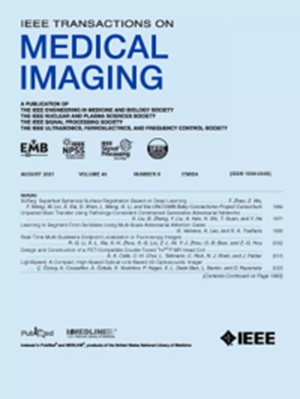Ray-Bundle Based X-ray Representation and Reconstruction: an Alternative to Classic Tomography on Voxelized Volumes.
IF 9.8
1区 医学
Q1 COMPUTER SCIENCE, INTERDISCIPLINARY APPLICATIONS
引用次数: 0
Abstract
Tomography recovers internal volume from projection measurements. Formulated as inverse problems, classic computed tomography generally reconstructs attenuation property in a preset cartesian grid coordinate. While this is intuitive and convenient for digital display, such discretization leads to forward-backward projection inconsistency, and discrepancy between digital and effective resolution. We take a different perspective by considering the image volume as continuous and modelling forward projection as a hybrid continuous-to-discrete mapping from volume to detector elements, which we call "ray bundles". The ray bundle can be regarded as an unconventional heterogenous coordinate. Projections are modeled as line integrations along ray bundles in the continuous volume space and approximated by numerical integration using customized sample points. This modeling approach is conveniently supported with an implicit neural representation approach. By representing the volume as a function mapping spatial coordinates to attenuation properties and leveraging ray bundle projection, this approach reflects transmission physics and eliminates the need for explicit interpolation, intersection calculations, or matrix inversions. A novel sampling strategy is further developed to adaptively distribute points along the ray bundles, emphasizing high gradient regions to allocate computational resources to heterogenous structures and details. We call this system T-ReX to indicate Transmission Ray bundles for X-ray geometry. We validate T-ReX through comprehensive experiments across three scenarios: simulated full-fan projections with primary signal only, half-fan setups with simulated scatter and noise, and an in-house dataset with realistic acquisition conditions. These results highlight the effectiveness of T-ReX in sparse view X-ray tomography.基于射线束的x射线表示和重建:体素化体上经典断层扫描的替代方法。
断层扫描从投影测量中恢复内部体积。经典的计算机断层扫描通常以反问题的形式在预先设定的笛卡尔网格坐标中重建衰减特性。虽然这对数字显示直观方便,但这种离散化导致了前后投影不一致,以及数字分辨率与有效分辨率之间的差异。我们采取了不同的视角,将图像体积视为连续的,并将正演投影建模为从体积到检测器元素的连续到离散的混合映射,我们称之为“射线束”。射线束可以看作是一个非常规的非均质坐标。投影建模为连续体空间中沿射线束的线积分,并通过使用自定义样本点的数值积分近似。这种建模方法方便地支持隐式神经表示方法。通过将体积表示为一个函数,将空间坐标映射到衰减属性,并利用射线束投影,这种方法反映了传输物理,消除了对显式插值、交叉计算或矩阵反转的需要。进一步提出了一种新的采样策略,沿射线束自适应分布点,强调高梯度区域,将计算资源分配给异质结构和细节。我们称这个系统为T-ReX,以表示x射线几何中的透射射线束。我们通过三种场景的综合实验来验证T-ReX:模拟只有主信号的全扇投影,模拟散射和噪声的半扇设置,以及具有现实采集条件的内部数据集。这些结果突出了T-ReX在稀疏视图x射线断层扫描中的有效性。
本文章由计算机程序翻译,如有差异,请以英文原文为准。
求助全文
约1分钟内获得全文
求助全文
来源期刊

IEEE Transactions on Medical Imaging
医学-成像科学与照相技术
CiteScore
21.80
自引率
5.70%
发文量
637
审稿时长
5.6 months
期刊介绍:
The IEEE Transactions on Medical Imaging (T-MI) is a journal that welcomes the submission of manuscripts focusing on various aspects of medical imaging. The journal encourages the exploration of body structure, morphology, and function through different imaging techniques, including ultrasound, X-rays, magnetic resonance, radionuclides, microwaves, and optical methods. It also promotes contributions related to cell and molecular imaging, as well as all forms of microscopy.
T-MI publishes original research papers that cover a wide range of topics, including but not limited to novel acquisition techniques, medical image processing and analysis, visualization and performance, pattern recognition, machine learning, and other related methods. The journal particularly encourages highly technical studies that offer new perspectives. By emphasizing the unification of medicine, biology, and imaging, T-MI seeks to bridge the gap between instrumentation, hardware, software, mathematics, physics, biology, and medicine by introducing new analysis methods.
While the journal welcomes strong application papers that describe novel methods, it directs papers that focus solely on important applications using medically adopted or well-established methods without significant innovation in methodology to other journals. T-MI is indexed in Pubmed® and Medline®, which are products of the United States National Library of Medicine.
 求助内容:
求助内容: 应助结果提醒方式:
应助结果提醒方式:


